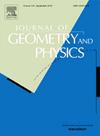Which symmetry group for elementary particles with an electric charge today and in the past?
IF 1.6
3区 数学
Q1 MATHEMATICS
引用次数: 0
Abstract
In this paper, we revisit the Kaluza-Klein theory from the perspective of the classification of elementary particles based on the coadjoint orbit method. The key conjecture is to consider the electric charge as an extra momentum on an equal footing with the mass and the linear momentum. We study the momentum map of the corresponding symmetry group which conserves the hyperbolic metric. We show that the electric charge is not an invariant, i.e. it depends on the reference frame, which is in contradiction with the experimental observations. In other words, it is not the symmetry group of the Universe today as we know it. To avert this paradox, we scale the fifth coordinate and consider the limit in which the cylinder radius ω vanishes. For the corresponding group , the charge is an invariant and therefore independent of the frame of reference and the observer. On this basis, we propose a cosmological scenario in which the elementary particles of the early Universe are classified from the momenta of the group , with the three former dimensions inflating quickly while the fifth one shrinks, leading to a 4D era in which as today the particles are characterized by the momenta of the group . By this mechanism, the elementary particles can acquire electric charge as a by-product of the symmetry breaking of the Universe. This work opens the way for the geometric quantization of charged elementary particles. We construct the corresponding -connections as a pullback connection over the space-time. Requiring that the linear 5-momentum is parallel-transported, we recover the conservation of the charge and the equation of motion with the Lorentz force. We revisit the variational relativity and obtain the field equations for both the gravitation and electromagnetic interactions with coupling terms which are negligible in the Newtonian approximation, allowing recovery of the Maxwell equations.
求助全文
约1分钟内获得全文
求助全文
来源期刊

Journal of Geometry and Physics
物理-物理:数学物理
CiteScore
2.90
自引率
6.70%
发文量
205
审稿时长
64 days
期刊介绍:
The Journal of Geometry and Physics is an International Journal in Mathematical Physics. The Journal stimulates the interaction between geometry and physics by publishing primary research, feature and review articles which are of common interest to practitioners in both fields.
The Journal of Geometry and Physics now also accepts Letters, allowing for rapid dissemination of outstanding results in the field of geometry and physics. Letters should not exceed a maximum of five printed journal pages (or contain a maximum of 5000 words) and should contain novel, cutting edge results that are of broad interest to the mathematical physics community. Only Letters which are expected to make a significant addition to the literature in the field will be considered.
The Journal covers the following areas of research:
Methods of:
• Algebraic and Differential Topology
• Algebraic Geometry
• Real and Complex Differential Geometry
• Riemannian Manifolds
• Symplectic Geometry
• Global Analysis, Analysis on Manifolds
• Geometric Theory of Differential Equations
• Geometric Control Theory
• Lie Groups and Lie Algebras
• Supermanifolds and Supergroups
• Discrete Geometry
• Spinors and Twistors
Applications to:
• Strings and Superstrings
• Noncommutative Topology and Geometry
• Quantum Groups
• Geometric Methods in Statistics and Probability
• Geometry Approaches to Thermodynamics
• Classical and Quantum Dynamical Systems
• Classical and Quantum Integrable Systems
• Classical and Quantum Mechanics
• Classical and Quantum Field Theory
• General Relativity
• Quantum Information
• Quantum Gravity
 求助内容:
求助内容: 应助结果提醒方式:
应助结果提醒方式:


